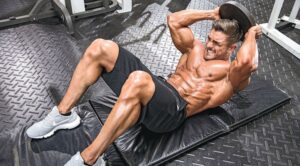Get back in fine form with this total-body workout from a top personal trainer and competitive athlete.
I talked to a few personal trainers to get their thoughts on the perfect workout plans for men. Each had their own version, but the one I liked best came from Matt Boyles, who dispelled the idea altogether: “There is no ‘perfect,’ and no one has it all together. There’s no set duration, no specific style, nothing you have to tick off to qualify what you’ve just done as a ‘good workout.’ Getting a bit fitter, stronger, more confident inside and out is about finding your rhythm with the elements of fitness that work for you.”
Boyles is the founder of Fitter Confident You, an online personal training and coaching program that’s like a trainer and a life coach combined, and with an Instagram bursting with raving before-and-afters to boot. He was more than happy to lay out some easy-to-start and easy-to-stick-to workout plans for men that target the entire body and which can be tailored to both your fitness goals and comfort level, broken down into four categories:
- Upper Body
- Core
- Lower Body
- Cardio
Once you’ve got these moves down, you can start assembling your own workouts, playing around with sets, repetitions, and duration, even adding equipment.
It’s important to note that, as with any new fitness regimen, it’s best to check with your doctor before beginning any new workout plan.
See below for everything to know about crafting a beginner’s workout plan.
Matt Boyles is the founder of Fitter Confident You, an online personal training and coaching program that’s like a trainer and a life coach combined.
-
Warm-up
Boyles recommends starting by marching on the spot for 30 seconds while moving each part of your body to get your blood pumping and mentally prepare yourself. Then, vary your movements: circle your arms, stand in place and twist your upper body, do a few half-depth squats, and rotate your ankles a few times in each direction while standing on one leg.
-
Upper Body
Areas Worked: Chest, Back, Arms (Biceps and Triceps), Shoulders

Push-ups (8 repetitions)
Try from a kneeling position first. Put your hands on the ground, slightly wider than your shoulders. Bend your elbows to lower your body to the ground. If possible, go all the way down. Don’t worry if you need to pause and re-set your hands before pushing yourself back up again.
Top tip: Play around with your hand position, as even quite small changes can make a big difference to how hard or easy you find these.
Press-up to Plank (8 repetitions: 4 leading with your left side, 4 leading with your right)
Start in the same position as for your push-ups. This time, lower yourself down to your left forearm, then your right forearm, then push back up to your left hand, then back up to your right hand. Well done!
Top tip: Squeeze your butt at the same time and focus on keeping your body as still as possible as you push up and lower yourself down.
Chest Press With No Weights (8 repetitions)
Standing up, put your palms together at chest height, fingers pointing out. Push your hands together as firmly as you can. Taking about three seconds, extend your arms straight out in front of you, then take 3 seconds to bring them back in, keeping your hands pushed firmly together throughout.
Top tip: Slow this down as much as you like to make it tougher; keep that pressure between your hands even.
-
Core
Areas worked: Abdominals/Mid-Section

Twists (20 repetitions)
Sit on the floor and lean back a few degrees until you feel your core start to have to work to stop you falling all the way back. Then, touch the ground on either side with a steady rhythm.
Top tip: Lift your feet off the ground to make this tougher, but keep your belly button pulled in tight the whole time to support your back.
Plank Punches (8 repetitions: 4 leading with your left side, 4 leading with your right
Get on your knees and forearms and walk your knees back until your body is in a straight line from your shoulders to your knees. Steadily extend one arm in front of you, bring it back, then extend your other arm, and keep alternating.
Top tip: Move to your forearms and toes to make this tougher, although it’s still very effective on your knees.
Don’t Spill the Drinks (8 repetitions)
Lie on your back and bring both legs to your chest. Keeping your shins parallel to the ground and steadily push both legs away, just a few inches the first time to check your back and core are happy with the move. To stay focused, imagine you’re balancing a tray of your favorite drinks on your shins—and don’t spill the drinks!
Top tip: As you start to push your legs away, your lower back will start to rise; fight this by pulling your belly button in tight and trying to glue your lower back down.
-
Lower Body
Areas worked: Legs (Quads and Hamstrings), Butt (Glutes)

Squats (8 repetitions)
Start by standing up with your legs just slightly wider than shoulder-width apart, though you may prefer to take a wider or closer stance—see what feels right. Bend your knees and start to lower your body to the ground, keeping your chest up, pushing your butt back, and keeping your heels down. Only go as low as feels right, then stand up and, most importantly, squeeze your butt hard each time.
Top tip: Want to make this tougher? Pause at the bottom of each squat for a few seconds.
Glute Bridges (16 repetitions)
Lie on your back; knees bent, feet flat, hands alongside your body. Lift your midsection and squeeze your butt hard each time.
Top tip: Lift one leg in the air and try Single Leg Glute Bridges! With these, keep your hips square to ensure you’re not favoring one side over the other.
Lunges (8 repetitions: 4 leading with your left side, 4 leading with your right)
From standing, take a big step forward with your left leg, dropping your right knee as low as is comfortable. Push back up to standing and then step forward with your right leg.
Top tip: Hold onto a wall or chair if you’re unsure how your knees or legs will feel doing lunges.
-
Cardio
Areas worked: Full Body, Heart, Lungs, Circulatory System, Mind

High Knees (20 repetitions)
From standing, raise one knee to waist height, put it down, and then raise your other knee, and keep alternating.
Top tip: As you get fitter, you can speed these up, bouncing on just your toes each time.
Jumping Jacks (20 repetitions)
From standing, jump both legs slightly wider and at the same time, raise both hands by your sides to overhead. Bring your arms down and jump your legs back together.
Top tip: Don’t want to disturb the neighbors below? Instead of jumping both legs out at the same time, step out your left foot and raise your left arm, then step back to the central position, then do the same on the right side and keep alternating.
Mountain Climbers (20 repetitions)
On your hands and toes, pull your left knee underneath your body, put it back and down, bring your right knee up, and keep alternating.
Top tip: Both slowing down and speeding up and can make these tougher! You can also bring your leg around the side, bending the knee and aiming to raise it to the elbow on the same side.
How often should I work out?
Boyles recommends starting twice a week and seeing how you feel. Some soreness (called DOMS or Delayed Onset Muscle Soreness) is a normal part of the muscle recovery process, especially at the beginning of any workout plans for men. Then gradually build up to several days a week.
Tips for Motivation
Set yourself some goals, especially at the beginning. According to Boyles, just saying “I want to feel better” is a great place to start. Then you can define bigger, more personalized goals:
- Things you want to avoid: Things we usually see as negatives about ourselves that we’d like to change, such as not being able to fit into your favorite jeans or getting out of breath after climbing a flight of stairs.
- Things you want to work towards: Here, you need to be a bit more specific, Boyles says. “Yes, wanting to get fitter, stronger, leaner, healthier is great. But how do you know when you’ve achieved it, and what do any of those really look like? Think about what you unlock when you get fitter, stronger, leaner, and healthier. What will you be able to do that you can’t do now?”
Rest Days
When you’re getting started, that rush of endorphins and sense of accomplishment can often convince you to push ahead, but Boyles warns against overdoing it. “Your body needs time to rest, recover and grow back stronger. In between specific workout days, a lovely walk or other light cardio is a nice way to keep it all ticking over, but sticking to rest days will ensure you never feel overwhelmed by your new habits.”
When it comes to the “perfect” workout plans for men, Boyles had this to say: “If anyone tells you [the perfect workout] is something other than doing something positive for yourself to help you feel good now and to futureproof your mind and body, walk away from them. You don’t need that negativity in your life!” We couldn’t agree more.
For more news and updates, follow IFBNewsfeed.Org on Facebook, Twitter, and Instagram.






